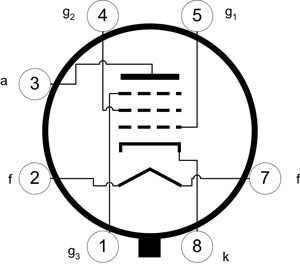i've had great success with my last post  i think if i stick around long enough, i'm bound to learn something.
i think if i stick around long enough, i'm bound to learn something.
since i dont really have that much advice to offer here i'll ask for some more instead
i was gigging with this amp for about a year it started to act very strangely so i stopped using it in favour of a fender transistor combo.
its been next to my wardrobe since
i have found
http://music-electronics-forum.com/t12724/
and
http://music-electronics-forum.com/t2082/
both of which are carlsbros with tube related issues, but not exactly the same.
the amp was fine and besides a few quirks which at the time i just didnt understand, sounded awesome.
i put it to the side after a weird sound at practise and only one tube was lit. (not a pop, squeal or crackle... just sounded odd while playing)
i discovered a physically cracked tube. (el34)
i changed it out for another and turned the amp on. it was definitely working but the tube i had put in started to glow seriously hot straight away. i turned it off and swapped the tubes around and the same socket made the tube glow again, i didnt give it much time before turning it off just in case. i guess whatever causes this was what made the original one crack?.
i'm not sure how long i ran it with one output tube but i'm sure thats not good for it.
if i am to do any of the tests suggested before, there are a couple of things i really would like cleared up first. just to make sure i dont do any damage to the amp.
1. in the posts above there are some tools for checking tubes and bias although i was under the impression i could do this with a multimeter?
do i need these?
2. secondly, i want to make sure i dont hurt the OT... so
if i turn the amp on i ALWAYS have a load connected, is this needed if in standby?
3. how safe is it to turn on the amp with no tubes in?
4. how likely is it that my load (speakers) will suddenly put out something at full volume while testing? i guess this one isnt really as important as the others
greatly appreciate any help or advice
 i think if i stick around long enough, i'm bound to learn something.
i think if i stick around long enough, i'm bound to learn something.since i dont really have that much advice to offer here i'll ask for some more instead

i was gigging with this amp for about a year it started to act very strangely so i stopped using it in favour of a fender transistor combo.
its been next to my wardrobe since

i have found
http://music-electronics-forum.com/t12724/
and
http://music-electronics-forum.com/t2082/
both of which are carlsbros with tube related issues, but not exactly the same.
the amp was fine and besides a few quirks which at the time i just didnt understand, sounded awesome.
i put it to the side after a weird sound at practise and only one tube was lit. (not a pop, squeal or crackle... just sounded odd while playing)
i discovered a physically cracked tube. (el34)
i changed it out for another and turned the amp on. it was definitely working but the tube i had put in started to glow seriously hot straight away. i turned it off and swapped the tubes around and the same socket made the tube glow again, i didnt give it much time before turning it off just in case. i guess whatever causes this was what made the original one crack?.
i'm not sure how long i ran it with one output tube but i'm sure thats not good for it.
if i am to do any of the tests suggested before, there are a couple of things i really would like cleared up first. just to make sure i dont do any damage to the amp.
1. in the posts above there are some tools for checking tubes and bias although i was under the impression i could do this with a multimeter?
do i need these?
2. secondly, i want to make sure i dont hurt the OT... so
if i turn the amp on i ALWAYS have a load connected, is this needed if in standby?
3. how safe is it to turn on the amp with no tubes in?
4. how likely is it that my load (speakers) will suddenly put out something at full volume while testing? i guess this one isnt really as important as the others
greatly appreciate any help or advice








Comment